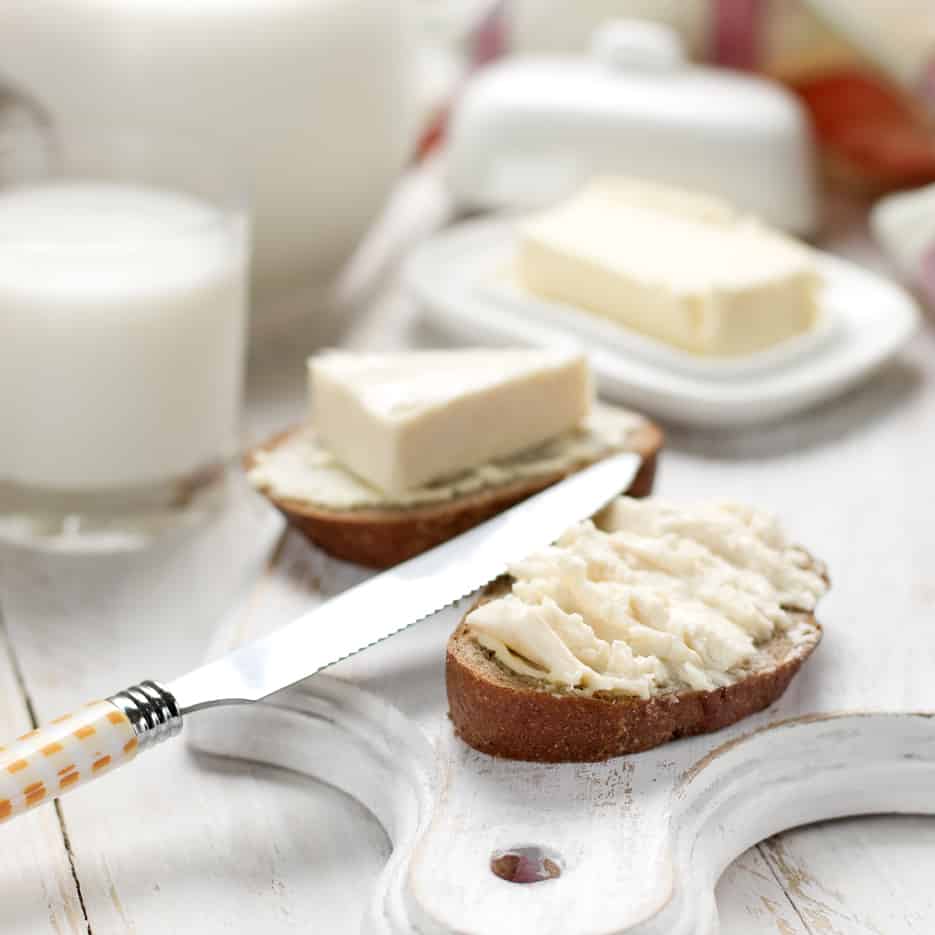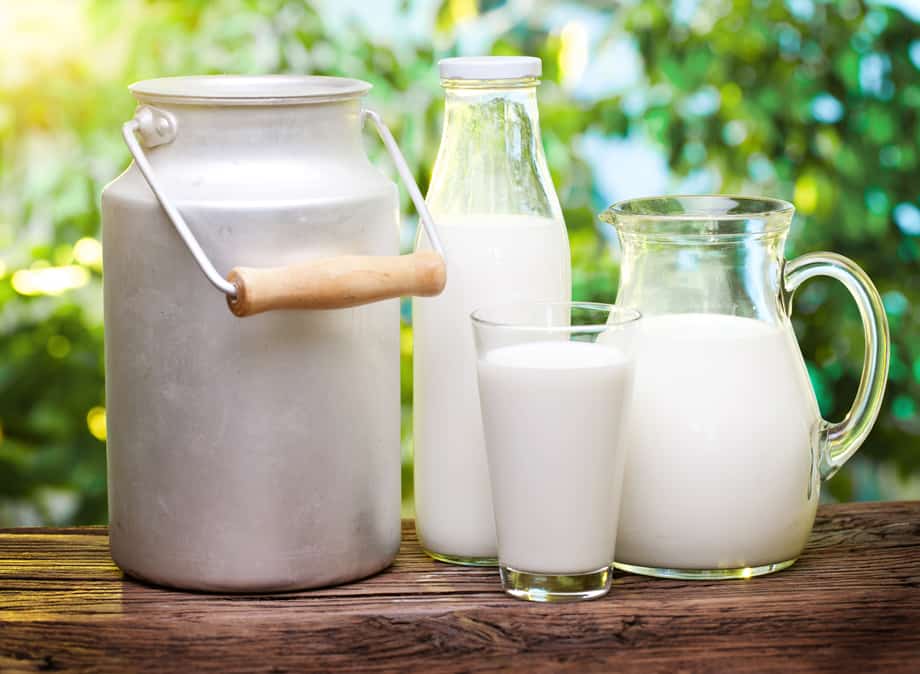![How to Make Cream Cheese [Homemade Recipe]](https://myfermentedfoods.com/wp-content/uploads/2019/08/1-Depositphotos_13376175_xl-2015.jpg)
Cream or Cheese… What do you like more? Well… I can understand that it is just too difficult to choose just one.

So, how about both? I mean ‘Cream Cheese’!
This will surely take the definition of delicious and yummy to the next level. Do you know you can treat yourself and your family with dishes topped with homemade cream cheese?
If you have never tried making cream cheese at home, keep reading to see the best cream cheese recipes and how to make them. We will start with the basics of cheesemaking by learning the equipment and ingredients needed. Let’s begin…
Table of Contents
Making cream cheese
If you are just getting started with making cheese at home, I feel cream cheese is the best option to try out first. Cream cheese is not just one of the yummiest cheeses but also easy to prepare.
Making cream cheese at home gives you control over what goes into the food your family eats.
You can make a healthier choice of ingredients and add herbs and spices that can enhance taste and flavors based on what you and your family like.
Making cream cheese at home can also make a lot of difference to how your dishes taste and look. If you find these as reasons enough to start making cream cheese at home, let’s get going with learning the recipes, ingredients, and equipment.

How long does it take to make cream cheese?
It takes about 18 to 24 hours to make cream cheese. However, it doesn’t mean cheesemaking will keep you busy and affect your routine schedule throughout this period. The actual time you need to put in to make cream cheese is just a few hours. The rest of the time goes into the process of fermentation that the ingredients manage on their own.
The reason behind letting you know it can take about 18 to 24 hours is to give you an idea when you need to start preparing it if you want it to be ready before any particular day or occasion.
Cream cheese making equipment
Remember I told you cream cheese is the best cheesemaking option for beginners to try? It is partly because you would probably already have most of the equipment needed to make it.
Large stainless-steel pot
You will, of course, need one large stainless-steel pot preferably with a lid to heat the milk in. Make sure the pot is big enough to hold the quantity of milk you are heating.
Choose a slightly bigger pot than the amount of milk as you will need some extra room for the other ingredients and to stir them together without spilling.
Avoid using an aluminum pot as it can react with acids that are released during cheesemaking and affect the flavor of the final cheese.
Thermometer
Cheesemaking involves monitoring the temperature of milk at regular intervals. A lot about how your homemade cheese comes out to be depends on whether the milk was heated to the correct temperature or not. This is why I advise you to invest in a kitchen thermometer.
You can use a cost-effective long stem thermometer. to get the temperatures right. Digital Thermometer is also a good choice, especially if you plan to get into cheesemaking on a regular basis.
Mixing spoon
You will need a large spoon for mixing the coagulant into milk. You can choose a wooden or plastic spoon. Even stainless steel spoon would work fine. Again, avoid aluminum spoon for the reasons discussed earlier.
Butter muslin or tight-weave towel
You will need one Butter Muslin or Tight-Weave Towel to drain the whey from the cheese curd to improve its consistency. Usually, a tight-weave dish towel works well. However, butter muslin is preferred as it makes draining of the whey easier and provides better results. The tightly woven cheesecloth can drain out whey leaving behind a thick and soft cheese curd.
Colander or Greek yogurt strainer
You will need a Colander or Greek Yogurt Strainer to drain your cream cheese. Add a bowl to the list of equipment to place the colander in. The larger the bowl, the better.

Cream cheese ingredients
The final outcome of cheesemaking depends on how carefully you choose the ingredients, particularly milk. So, don’t miss reading this section! This is where we will take a deeper look at how to choose the right milk for making cream cheese and the other ingredients needed.
Milk
Milk is, of course, the basic ingredient needed for making cheese. You can also choose cream in place of milk if you want the cheese to be thicker and creamier.
Let us have a look at the different options of milk you can try for making cream cheese and how each of it affects the taste and texture.
Whole milk
Most cheeses, particularly cream cheese, comes out the best when made from whole milk. You can get pasteurized whole milk from your grocery store or fresh raw milk from a farm.
However, avoid using ultra-pasteurized milk. This milk is heated to a very high temperature so that all the native bacteria and enzymes in it are completely destroyed. So, it will not form a curd that you will need to make cream cheese.
Even if you make an attempt to make cheese using ultra-pasteurized milk, it will turn out to be a mush looking more like ricotta.
Want to SAVE BIG on all your shopping?
Click Here to try Amazon Prime 30-Day FREE Trial
Skim milk
You can use skim milk only if you are making hard cheeses such as Romano and Parmesan. You can blend a portion of skim milk with whole milk to make Mozzarella and Monterey Jack.
Skim milk is considered a good option when you want to reduce the fat content of your cheese to make it a bit healthier. However, keep in mind, it may not have that rich and creamy taste you expect from the cream cheese.
So, it depends on you whether you want to use whole milk to satisfy your taste buds or skim milk to make it healthier. You also have the option of adding both in varying proportions depending on your priorities: taste vs health.
Raw milk
Raw milk from a cow or a goat can bring in its own unique flavors to your homemade cream cheese. Raw milk is milk that has not been heated to destroy the bacteria present in it. Most of the bacteria and enzymes in raw milk are good for cheesemaking.
Also, the bacteria in the starter culture such as lactobacillus are native to raw milk. So, you can reduce the quantity of starter when using raw milk to make cheese.
Moreover, enzymes in raw milk can contribute to the complexity of the flavors and enhance the texture and taste of the cream cheese.
However, if you plan to use raw milk, make sure it is obtained from healthy animals and handled properly to prevent contamination.
Cow milk vs goat milk

Store-bought cow milk is usually homogenized and pasteurized. Homogenization breaks up the butterfat globules in the milk into uniformly-sized particles. This ensures the larger fat globules of cream are distributed throughout the milk uniformly and so, do not rise to the top when it is processed.
Goat’s milk is naturally homogenized, which means all the fat molecules in it are of the same size. And hence, mechanical homogenization is not required. This is why the flavors of cheese made from goat’s milk may seem to be more natural.
If possible, try to get goat’s milk for making cream cheese. It is also more acidic than cow’s milk. This will help to reduce the ripening time and yield cream cheese that is softer.
Coagulant
There are several options of coagulants you can choose. You can add the store-bought Cream Cheese Starter Cultures, which are usually available in ready-to-use packets. Most store-bought coagulant products contain both the starter culture as well as rennet.
Cheese Salt
This is optional. You can add a bit of cheese salt to the finished cheese to kick up its flavors. The rule of thumb is to add 2 teaspoons of salt per one pound of cream cheese. However, you can increase or decrease the ratio based on your preferences.
Print
Cream Cheese Recipe
- Total Time: 18 to 24 Hours
- Yield: 1/2 a pound 1x
Description
This is a step-by-step recipe for making cream cheese using whole milk. You can use this cream cheese as a spread on bread and crackers. You can also use it as a base for cheesecake, dips, and frosting.
Ingredients
- Half a gallon of whole milk
- One packet of cream cheese culture mixture
- Salt to taste
Instructions
- The first step is to culture the milk. Heat the milk on a low to medium heat. Attach the thermometer to the pot to monitor the temperature. The suitable temperature to heat milk at this step is about 80° to 86°F.
- Remove the pot from the heat and stir in a packet of cream cheese culture mixture. Stir well using a wooden or stainless-steel spoon for about 10 to 15 seconds. Avoid mixing the contents vigorously.
- Cover the pot with a lid to allow the mixture to culture for about 12 hours at a temperature of 72° to 77°F.
- Check the contents once in a while after 12 hours until it appears like yogurt. You may also see the whey separating from the cheese. The whey looks like a clear liquid.
- Place a piece of butter muslin or a tight weave towel in a colander placed in a bowl. Pour the cultured milk into the towel or butter muslin gently. Gather the corners of the cloth and hold them up to tie knots to secure.
- Then, hang the tied butter muslin containing cultured milk over a bowl to allow the whey to drain. It may take about 6 to 12 hours for the cream cheese to drain completely and reach the desired consistency.
- Add salt as per taste and knead gently.
Notes
- Add extra cream to whole milk before heating it if you want the cheese to be creamier.
- Be careful while heating the milk. Heating milk too quickly can prevent it from setting properly and cause the cheese to taste a bit unpleasant later.
- If you want to make a larger batch of cream cheese, use the same proportion of ingredients. Add the contents in multiplied amounts of quantities to maintain the same ratio of whole milk and starter.
- You can spice up the cream cheese with different flavors! Add herbs or spices like cinnamon, garlic, or oregano to enhance flavors depending on your taste and preferences.
- Allow the milk to ferment for a longer duration if you want the cream cheese to have a tangier taste.
- Prep Time: 1 hour
- Cook Time: 1 hour
- Category: Dairy product
- Method: Fermentation
- Cuisine: British
How to store cream cheese?
You can store cream cheese in the refrigerator for up to 10 days. Place it in an air-tight plastic container or a zip-sealed bag.
Do not forget that store-bought cheese tends to last much longer because of the preservatives added to it. The above recipe for homemade cream cheese does not contain any preservatives. Hence, it is best to store it in the fridge and use it up within 10 days.
Conclusion
After learning how simple it is to make cream cheese, you must be wondering why you never tried it earlier. But, as they say, it’s never too late to start! How about getting started now by checking out which equipment and ingredients you have and which you need to buy? Seems like a good idea, doesn’t it?
Happy cheesemaking!

Have you considered using Sheep milk for this recipe? With the higher milk fat content of sheep milk it would seem to be a benefit, but I am just guessing.
I haven’t tried making the cream cheese with sheep’s milk but I believe it would be equally tasty.